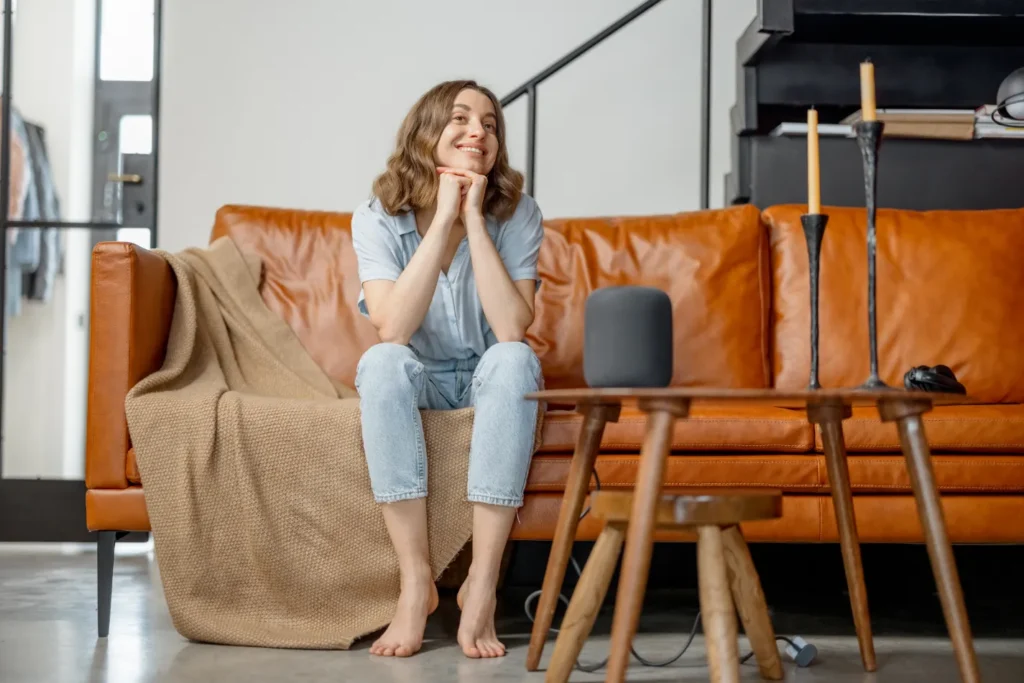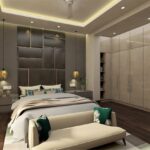Positively Impacting Interior Design with Sound Aesthetics: 5 Proven Tips
Overview
Discover how sound aesthetics revolutionize interior design. Learn 5 powerful tips for a harmonious and positive living space.
In the grand tapestry of existence, design emerges as the architect of culture, and culture, in turn, molds the values that pave the path to the future.
Robert L. Peters
In the modern world, our living spaces have assumed a significance that transcends mere functionality. They have evolved into vessels of self-expression and repositories of our values and beliefs. Interior design, as the medium through which we mold these spaces, goes beyond being a mere visual endeavor. It becomes the canvas upon which our personal preferences, lifestyle choices, and the very cultural essence of our homes are painted.
This blog embarks on a captivating journey deep into the heart of interior design, seeking to shed light on a crucial yet often underestimated aspect: acoustics. Acoustics, the intricate science of sound, occupies a less prominent position compared to design elements like color palettes and furniture selections. However, it is an essential and often overlooked dimension that plays a pivotal role in shaping our living experience.
Interior design, in its essence, extends beyond the visual domain. It encompasses the way sound traverses through space, how it dances with surfaces, and the emotional resonance it creates within its inhabitants. Sound, with its ethereal quality, wields the extraordinary power to elicit emotions, craft atmospheres, and impart unique personalities to spaces. Acoustics, although invisible, function as the life force that connects our senses and emotions, ultimately transforming a mere house into a cherished and harmonious home.
As we delve into the intricate science of sound, we will explore its behaviors in diverse settings, pinpoint the sources of disruptions, and uncover the methods through which it can be harnessed to create harmony. Moreover, we will investigate the common acoustic challenges that homeowners encounter and provide practical solutions suitable for both do-it-yourself enthusiasts and seasoned professional designers. So, whether you’re an aspiring homeowner looking to enhance your living environment or an interior design professional seeking to expand your knowledge and skills, this blog promises to be a valuable resource in understanding how the sound of a space can deeply resonate with our senses and emotions, making every dwelling truly feel like a home.
Basics Of Acoustics In Interior Design

In the sphere of interior design, acoustics refers to the investigation and practical utilization of sound control measures within a designated space. It encompasses the science of sound, encompassing its production, transmission, and reception, and how it interacts with the architectural elements and materials in a room.
To put it simply, acoustics in interior design involves the deliberate manipulation of sound to enhance the auditory experience of a space. Whether it’s minimizing unwanted noise, optimizing sound quality for music or speech, or creating a tranquil environment, acoustics are a critical factor.
The Importance Of Sound Control In Residential Spaces
Noise Pollution and Well-Being: Uncontrolled sound in a residential space can lead to what is commonly known as noise pollution. Constant background noise from traffic, neighbors, or household appliances can cause stress, sleep disturbances, and reduced concentration. Therefore, sound control is essential for maintaining a peaceful and healthy living environment.
Privacy and Comfort: Imagine a scenario where you can hear every word of your neighbor’s conversation through the thin walls of your apartment. It not only violates one’s privacy but also serves as a cause of annoyance. Proper sound control allows for privacy, ensuring that your space remains your sanctuary.
The Role Of Acoustics In Creating A Harmonious Living Environment
Sound and Space: The layout and design of a room can greatly affect how sound behaves within it. For instance, open, minimalist spaces tend to have more sound reflection and may require sound absorption elements to prevent excessive reverberation. In contrast, smaller rooms may need sound diffusion to prevent echoes and create a comfortable atmosphere.
Materials and Furnishings: The materials used in a space, from hard surfaces like glass and concrete to soft materials like curtains and upholstery, influence the way sound travels. Carefully selecting and placing these materials can significantly impact the acoustics of the space. For example, soft materials can absorb sound, reducing echo and creating a quieter environment.
Harmonizing Sound and Aesthetics: Achieving acoustic balance doesn’t mean sacrificing aesthetics. Interior designers can seamlessly incorporate acoustic solutions into their projects. Consider decorative sound panels, acoustic wall art, or even furniture with integrated sound-absorbing features. These elements not only serve a functional purpose but also add an artistic touch to your living space.
Picture a living space featuring a lofty ceiling, expansive windows, and hardwood flooring. While these design elements contribute to an elegant look, they can also lead to sound reflections and increased noise levels. In this scenario, an interior designer might suggest adding area rugs, plush furniture, and sound-absorbing curtains to mitigate the acoustic challenges while maintaining the room’s aesthetic appeal.
In conclusion, acoustics in interior design is an essential element for creating a comfortable, peaceful, and harmonious living environment. Through a grasp of the meaning of acoustics and the significance of sound management, interior designers and homeowners can collaborate to achieve an ideal equilibrium between visual appeal and sound quality, guaranteeing that each area becomes a haven for its inhabitants.
Sound Absorption And Its Impact On Interior Design

Sound absorption is a critical aspect of interior design that greatly influences the comfort and ambiance of a space.
Sound Absorption Materials And Methods
Sound absorption involves the reduction of sound reflections within a room. This is achieved through the use of materials and techniques that absorb sound energy rather than allowing it to bounce around. Common sound absorption materials include acoustic panels, foam, and specialized fabrics. Methods may involve strategic placement of these materials on walls, ceilings, or floors. For instance, acoustic panels are designed to capture sound waves and prevent them from reflecting, which makes them a popular choice in interior design.
Use Of Soft Materials Like Curtains, Carpets, And Upholstery
Materials with a soft texture, like curtains, carpets, and upholstery, play a crucial role in absorbing sound within the realm of interior design. They are not only functional but also versatile in enhancing the aesthetic appeal of a space.
Curtains made of heavy, densely woven fabrics effectively absorb sound, especially in rooms with large windows. Carpets, particularly those with thicker and softer piles, serve as excellent sound absorbers on floors. The plushness of upholstery materials in furniture can also contribute to sound absorption.
How Sound Absorption Enhances Comfort And Reduces Noise Pollution
Sound absorption is instrumental in creating a comfortable and serene living environment. By reducing the level of background noise and echoes, soft materials, and other sound-absorbing elements make conversations more intelligible, enhance the quality of music and media playback, and provide a more peaceful atmosphere.
Imagine a cozy living room with soft upholstered furniture and curtains that absorb sound effectively. In this setting, family members can engage in conversations without having to raise their voices to be heard over competing noises from outside. Moreover, the room’s acoustic quality allows for a more immersive movie-watching experience, as sound reflections are minimized.
Let’s examine a few practical instances where sound absorption has been a pivotal element in interior design:
Home Office Oasis: In a home office, where concentration is key, sound absorption is vital. By strategically placing acoustic panels on the walls and incorporating soft furnishings, a homeowner created an oasis of productivity. The sound absorption not only reduced external noise interference but also made the space acoustically suitable for virtual meetings and conference calls.
Cozy Bedroom Retreat: In a bedroom, a sanctuary for rest and relaxation, the use of soft materials like heavy curtains and a plush carpet transformed the space into a serene retreat. The curtains absorbed external noises, ensuring a peaceful night’s sleep, while the carpet minimized sound reflections, creating a tranquil ambiance.
In summary, sound absorption is a powerful tool in interior design, with the use of soft materials like curtains, carpets, and upholstery being an effective method. It not only enhances comfort but also reduces noise pollution, making your interior spaces more enjoyable. The provided case studies exemplify how sound absorption can be practically applied to improve the quality of life in your home while harmonizing aesthetics and acoustics.
Sound Reflection In Interior Design

Sound reflection is a pivotal element in interior design, wielding considerable influence over the overall ambiance and auditory experience within a given space. In the subsequent section, we will delve into the intricate concept of sound reflection within interior settings. This discussion will encompass the role of hard surfaces like mirrors, glass, and tiles and underscore the imperative of striking a harmonious balance to craft an inviting atmosphere. Real-life examples will be offered to illustrate the practical applications of sound reflection in interior design.
Comprehending Sound Reflection In Interior Spaces
Sound reflection, in essence, pertains to the phenomenon where sound waves rebound off surfaces rather than being absorbed. Within the realm of interior spaces, these reflections can either augment or hinder the acoustic quality of a room. A profound understanding of sound reflection is vital for designers and homeowners alike, as it empowers them to fashion spaces that seamlessly marry visual allure with acoustic comfort.
When sound waves encounter unyielding, reflective surfaces such as walls, ceilings, and floors, they typically oscillate back and forth, engendering echoes and exacerbating noise levels. This scenario can lead to an unsatisfactory auditory experience, particularly in open-plan living areas, offices, or hallways.
The Role of Hard Surfaces: Mirrors, Glass, and Tiles Interior designers frequently integrate hard and reflective surfaces into their designs to fulfill specific aesthetic objectives. Mirrors can create an illusion of spaciousness and enhance brightness, glass elements convey transparency and openness, and tiles offer a sleek and clean appearance. Nonetheless, these rigid surfaces can also serve as conduits for sound reflection.
For instance, envision a bathroom adorned with glass shower doors and tiled walls, generating a visually striking effect. However, these hard surfaces may inadvertently propagate sound reflections, giving rise to a noisy and acoustically uncomfortable environment. This underscores the vital need for balancing aesthetics with acoustics.
Harmonizing Sound Reflection For An Inviting Ambiance
Attaining equilibrium between sound reflection and absorption stands as the crux of creating an inviting ambiance within interior spaces. While reflective surfaces infuse spaces with visual intrigue and style, they must be complemented by sound-absorbing elements to stave off excessive sound reverberations.
Consider, for instance, a restaurant characterized by hard surfaces such as exposed brick walls and expansive glass windows. To mitigate sound reflections, interior designers might introduce sound-absorbing ceiling panels and plush furnishings, thereby striking a balance between aesthetic appeal and acoustic comfort.
Instances Of Sound Reflection In Interior Design
Contemporary Office Spaces: In the realm of modern office design, glass partitions and open-plan layouts are favored for their ability to foster collaboration and communication. However, these designs often engender sound reflections that may prove distracting to employees. To address this concern, interior designers frequently incorporate acoustic ceiling treatments and sound-absorbing dividers to establish a harmonious equilibrium between aesthetics and acoustic well-being.
Hotel Grand Foyers: Hotel foyers, characterized by grand designs featuring marble floors and expansive glass facades, exude opulence. However, these opulent materials have the potential to generate echoes and high noise levels. To address sound reflection concerns, designers judiciously employ strategically positioned fabric wall coverings, area rugs, and upholstered seating. These elements not only absorb sound but also preserve an ambiance of elegance and tranquility.
Soundproofing For Privacy And Tranquility

Soundproofing is an essential component of interior design, and its significance cannot be overstated. In this section, we’ll explore why soundproofing is crucial in homes, delve into the materials and techniques employed, and focus on its specific roles in bedrooms, home offices, and media rooms. Additionally, we’ll share success stories of homeowners who have significantly enhanced their living spaces through soundproofing.
The Significance Of Soundproofing In Homes
Soundproofing is the craft of establishing a barrier that effectively hinders the passage of sound in or out of a room. Within a household context, this can wield a substantial influence on the overall quality of one’s daily life. The significance of soundproofing is multi-faceted:
Privacy: In homes, we cherish our privacy. Soundproofing ensures that conversations, TV sounds, or music playing in one room do not disrupt the tranquility of other spaces, allowing family members or housemates to coexist peacefully.
Productivity: Soundproofing is particularly crucial in home offices, where concentration is paramount. By minimizing external noise, professionals can work without interruptions, enhancing their productivity.
Relaxation: In bedrooms, where we seek rest and relaxation, soundproofing helps create a serene and peaceful atmosphere. It shields us from outside noises, contributing to better sleep and well-being.
Soundproofing Materials And Techniques
Soundproofing involves various materials and techniques to achieve the desired results. Common materials include:
Mass-Loaded Vinyl: This dense material can be added to walls, floors, and ceilings to block sound.
Acoustic Panels: These panels absorb sound and reduce noise reflections within a room.
Weatherstripping: Used around doors and windows to seal gaps and prevent sound infiltration.
Techniques for soundproofing include the use of double or staggered walls, resilient channels, and creating an air gap between surfaces. Soundproof curtains and rugs are also practical additions that dampen noise and enhance the acoustic environment.
Role Of Soundproofing In Bedrooms, Home Offices, And Media Rooms
Bedrooms: In bedrooms, soundproofing contributes to a peaceful atmosphere that promotes restful sleep. Soundproofing materials added to walls, windows, and doors can block out external noises, ensuring you wake up refreshed.
Home Offices: In home offices, soundproofing is a game-changer for professionals who need a quiet environment to concentrate. By soundproofing walls, ceilings, and floors, distractions from household activities are minimized, enhancing work efficiency.
Media Rooms: In media rooms, soundproofing enhances the audio experience while preventing sound leakage. Acoustic panels, carpeting, and soundproofing drywall can create a cinematic experience without disturbing others in the house.
Homeowners And Professionals
Consider Jane, a homeowner who transformed her noisy apartment into a peaceful haven with soundproofing. By adding mass-loaded vinyl under her hardwood floors and using soundproof curtains, she was able to enjoy quiet evenings even with neighbors playing loud music.
John, a remote worker, found that soundproofing his home office made a world of difference. With resilient channels on the walls and acoustic panels, he created a workspace free from household noises, significantly improving his productivity.
In another instance, the Smith family’s media room underwent a transformation with the addition of acoustic panels and carpeting. Now, their movie nights are immersive, and they no longer worry about disturbing the rest of the house.
Soundproofing is a silent hero in interior design, ensuring privacy and tranquility in our homes. With the right materials and techniques, you can create spaces that offer respite from external noise and support your daily activities, ultimately enhancing your overall quality of life.
Conclusion

Concluding our journey through the intricate world of acoustics in interior design, we have unveiled the profound influence sound management wields over our living spaces. This often-overlooked aspect intricately weaves together the aesthetics and functionality of our homes, playing a subtle yet profound role in our daily lives.
Sound, far beyond being a mere auditory experience, possesses the unique power to shape our emotions and influence our overall experiences. The choices we make when it comes to selecting materials, arranging furnishings, and integrating technology extend beyond mere visual appeal.
The understanding of acoustics in interior design is not confined solely to professionals but is a valuable asset for homeowners. Homeowners can effectively create spaces that radiate warmth, comfort, and tranquility through thoughtful yet straightforward choices, such as the careful selection of curtains, rugs, or the strategic placement of furniture.
From the comforting embrace of soft textiles to the alluring gleam of glass, we have discovered how sound can be a powerful ally or a potential adversary. By harnessing the potential of acoustics and sound management, we can expertly mold our living spaces to promote relaxation, enhance productivity, and inspire creativity.
Whether we’re considering a serene bedroom retreat, a productive home office sanctuary, or an immersive media room, we’ve witnessed how sound plays a pivotal role in shaping our daily experiences. The success stories of homeowners who have harnessed soundproofing to craft peaceful retreats serve as compelling proof of the merits of these principles.
In the domain of interior design, it is abundantly clear that aesthetics alone do not suffice. It is about crafting spaces that resonate with our senses and evoke our deepest emotions. Acoustics and sound design operate subtly, like the skilled members of a symphony orchestra, molding our moods and enriching our lives. As we continue to explore the ever-evolving landscape of interior design, let’s remain mindful of the harmonious symphony of sound that truly transforms houses into homes.
At The White Frame, we turn extravagant dreams into functional, well-crafted realities. We handcraft luxurious homes, tailored to the preferences of our diverse clientele in Gurgaon, Noida, and Delhi NCR. We’re redefining the notion of modern opulence, proving that luxury doesn’t have to strain the budget. We’re driven by a core belief that our in-house technology streamlines processes, making the journey to your dream home effortless and trouble-free. Our team of designers is well-versed in optimizing space, and crafting functional, aesthetically pleasing interiors that exude class, sophistication, and beauty.
Explore some of our work here!









